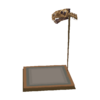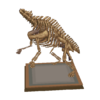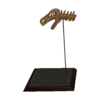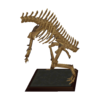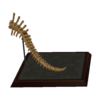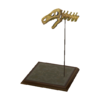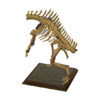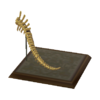Iguanodon
The Iguanodon is a three-part fossil in the Animal Crossing series introduced in Animal Crossing: Wild World that appears in all subsequent games.
At the museum
In Wild World
In City Folk
In New Leaf
After donating the final part of the fossil in New Leaf, its plaque in the museum will read:
"The iguanodon is so named because it was mistakenly believed to be a large iguana. An herbivore, it is famous for its spikelike thumb claws, which seem somewhat odd on a nonpredator. Supposedly it would run on two legs but would use all four when it was just walking at its leisure."
In New Horizons
As an item
In Wild World
| Iguanodon skull | |
|---|---|
| Sell price | |
| Colors | Brown
Brown
|
| HRA genre | Old-school |
| Size | |
| Iguanodon torso | |
|---|---|
| Sell price | |
| Colors | Brown
Brown
|
| HRA genre | Old-school |
| Size | |
| Iguanodon tail | |
|---|---|
| Sell price | |
| Colors | Brown
Brown
|
| HRA genre | Old-school |
| Size | |
In City Folk
| Iguanodon skull | |
|---|---|
| Sell price | |
| Colors | Brown
Brown
|
| HRA genre | Retro |
| Size | |
| Iguanodon torso | |
|---|---|
| Sell price | |
| Colors | Brown
Brown
|
| HRA genre | Retro |
| Size | |
| Iguanodon tail | |
|---|---|
| Sell price | |
| Colors | Brown
Brown
|
| HRA genre | Retro |
| Size | |
In New Leaf
| Iguanodon skull | |
|---|---|
| Sell price | |
| Colors | Brown
Brown
|
| Style | Historical |
| HHA theme challenge | Quirky |
| Size | |
| Iguanodon torso | |
|---|---|
| Sell price | |
| Colors | Brown
Brown
|
| Style | Historical |
| HHA theme challenge | Quirky |
| Size | |
| Iguanodon tail | |
|---|---|
| Sell price | |
| Colors | Brown
Brown
|
| Style | Historical |
| HHA theme challenge | Quirky |
| Size | |
In New Horizons
| Iguanodon skull | |
|---|---|
| Interactable | No |
| Sell price | |
| Colors | Brown
Brown
|
| Size | |
| Iguanodon torso | |
|---|---|
| Interactable | No |
| Sell price | |
| Colors | Brown
Brown
|
| Size | |
| Iguanodon tail | |
|---|---|
| Interactable | No |
| Sell price | |
| Colors | Brown
Brown
|
| Size | |
Real-world information
Iguanodon was an herbivorous ornithopod dinosaur which lived in Europe. It is one of the first named genera of dinosaur, described by Gideon Mantell in 1824 and named by Friedrich Holl in 1829. While multiple species ranging from the Late Jurassic to Early Cretaceous have historically been classified as Iguanodon, reclassification efforts during the 21st century limited the genus to only two species living 126-122 million years ago in the Early Cretaceous. It was up to 10 meters long, weighed 3 tons, and sported a beak with iguana-like teeth (hence the name). Its most notable anatomical feature was a thumb spike, which Mantell originally misinterpreted as a horn on the nose.
More information on this topic is available at Wikipedia.
| Fossils | ||||||||||||||||||||||||
|---|---|---|---|---|---|---|---|---|---|---|---|---|---|---|---|---|---|---|---|---|---|---|---|---|
| ||||||||||||||||||||||||




